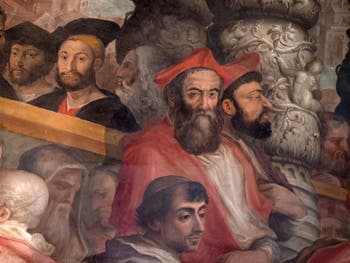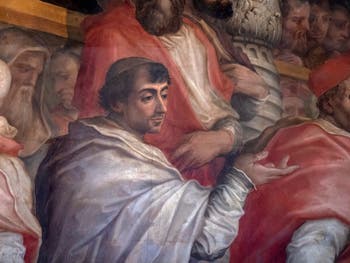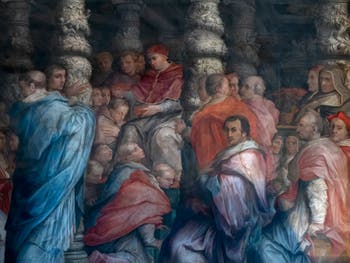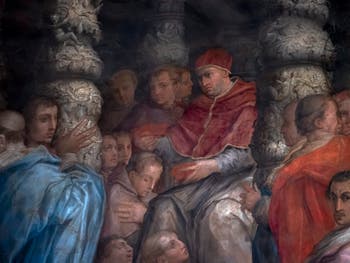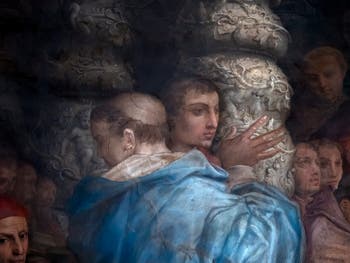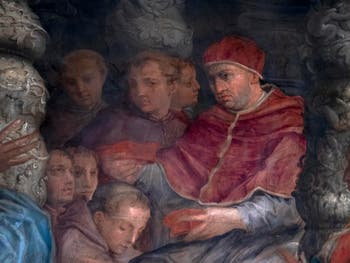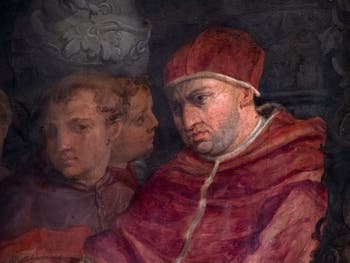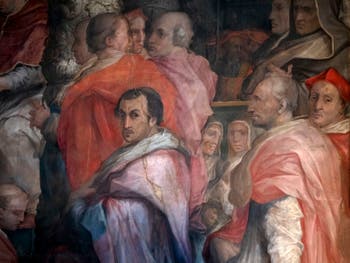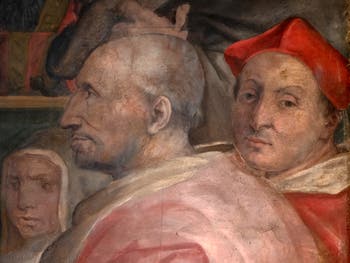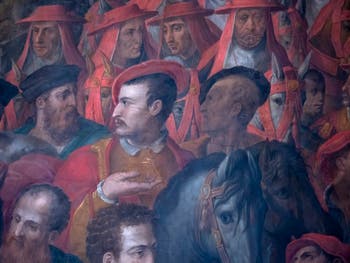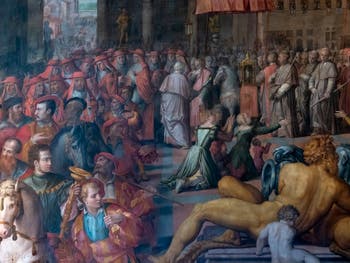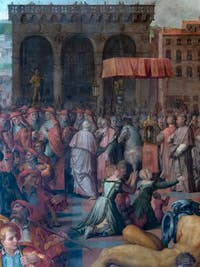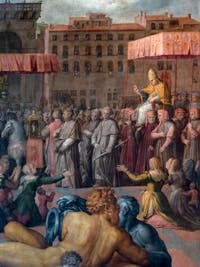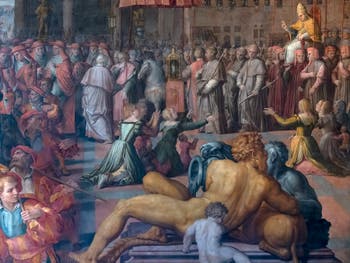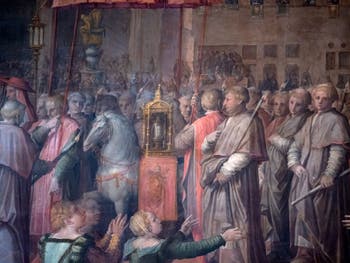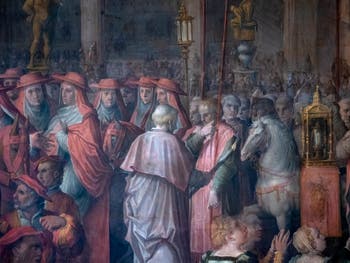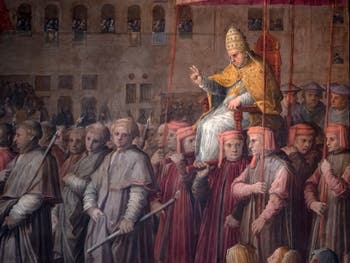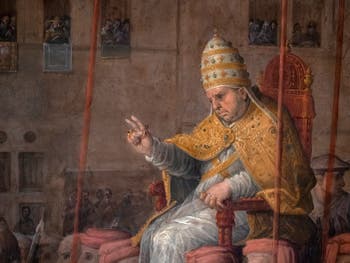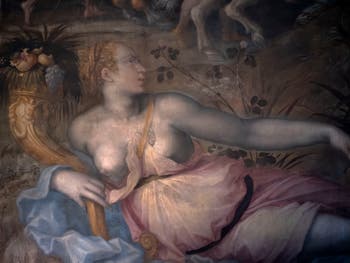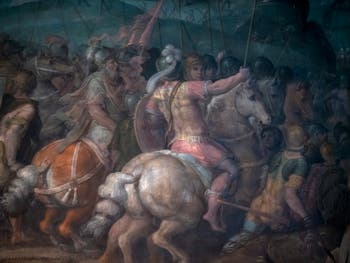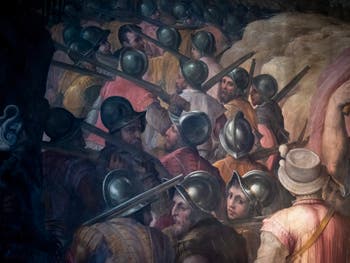Palazzo Vecchio Art Story | Location | Opening Hours Tickets | Authorizations
Art Story Five-Hundred | Tower | Vasari Halls | Dante Mask | Ghirlandaio | Bronzino Sarto Daddi | Salviati | Cortile
Vasari Halls Cosimo Elder | The Magnificent | Penelope Esther Sabines | Pope Leo X
Giorgio Vasari, Hall of Pope Leo X John of Medici, Palazzo Vecchio in Florence Italy
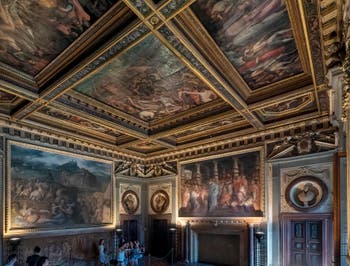
Hall of Pope Leo X John of Medici (1475-1521) was the son of Lorenzo the Magnificent and Clarisse Orsoni.
He was elected Pope at the age of thirty-seven on March 11 1513, under the name of Leo X, until his death on December 15 1521.
After the election of Leo X and the return of the Medici to power, Nicolas Machiavelli, who was imprisoned by the former Republican Florence’s Government, benefited from grace.
He took advantage of his recovered freedom to write his famous book “The Prince” the very summer of his liberation, a book written in part to the glory of Leo X's father, Lorenzo the Magnificent.
Leo X used his position as Pope to support Fine Arts and culture in general, thus following in the footsteps of his father, Lorenzo the Magnificent, by becoming one of the greatest patrons Rome had known.
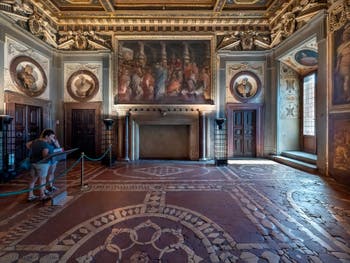
Hall of Pope Leo X Determined to make Rome the artistic capital of Italy, he used not to mention the finances of the Vatican and his personal finances to support the arts.
He opened the Vatican Library to all scholars and artists, which he enriched with many new books and manuscripts.
He also helped develop the Academy of Rome and the revival of the Roman University by multiplying the premises and the number of professors.
Erasmus himself praised Leo X for his involvement in the development of arts and letters and his humanity and kindness.
Erasmus said, comparing Leo X to his predecessor Julius II, “An Iron Age was suddenly transformed into a Golden Age.”
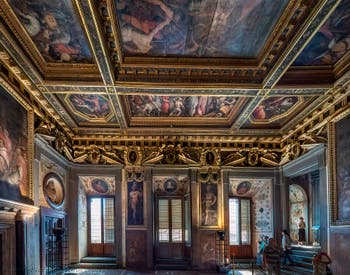
Hall of Pope Leo X The Venetian Pietro Sarpi, however, very critical of the papacy said of Leo X:
“Leo, a nobleman of birth and culture, brought many skills to the papacy, in particular, a remarkable knowledge of classical literature, humanity, goodness, greater liberality, and a confessed intention to support artists and scholars who for many years had not benefited from any favour to the Holy See.”
Pietro Paolo Sarpi
The pontificate of Leo X marks the beginning of what was called the Age of the High Renaissance.
But Leo X's love for arts and culture also extended to the sumptuous festivals and expenses that characterised his pontificate.
And to deal with it, he multiplied the sale of plenary indulgences.
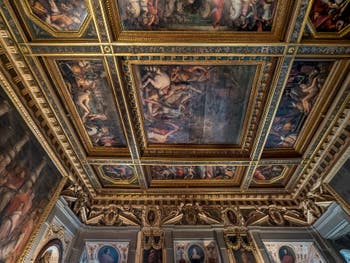
Hall of Pope Leo X These excesses prompted Luther to create the reformation in response to the pontificate of Leo X.
It was Leo X who excommunicated Luther, and we know the rest.
Therefore, this Hall Leo X was an opportunity for Giorgio Vasari to glorify the action of this Pope Medici. A glorification of the Medici as an expression of the divine will.
In addition to the ceiling, which is completely decorated with paintings, the walls present the different stages of Leo X's life and the works of the Medici.
We see the architect Bramante presenting to Pope Leo X the plan of the future basilica of St. Peter, Leo X naming cardinals or the Pope's visit to Florence.
Giorgio Vasari “Election of a new college of cardinals by Pope Leo X” Palazzo Vecchio in Florence Italy
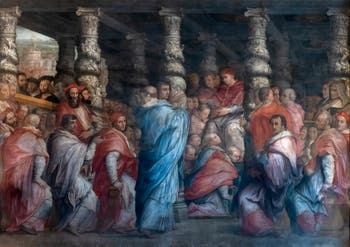
Election of college of cardinals After his election to the throne of Saint Peter, Leo X, to thank the friends and cardinals who had supported him to become Pope, gave them many privileges very generously to them and their families.
An attitude that displeased many of the cardinals in place who then tried to assassinate him through the Pope's doctor who was supposed to poison him.
The plot was foiled, and the perpetrators punished.
Following this assassination attempt and aware of the threatening attitude of many of the cardinals towards him, Leo X decided to create a new college of cardinals.
And to be sure that he could control this new college, Leo X appointed 31 new cardinals at once.
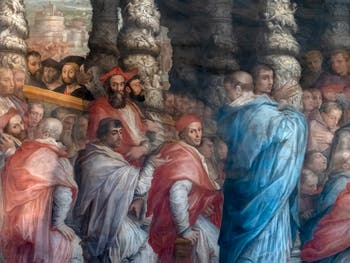
Election of college of cardinals This event represented here by Vasari took place on June 26, 1517.
Leo X stands in the centre of the fresco.
Among the three cardinals that can be seen on foot in the foreground and on the left of the fresco, the central character with his hand facing upwards is Giulio de Medici.
Giulio de Medici was the posthumous and illegitimate son of Giuliano de Medici, the brother of Lorenzo the Magnificent, who lost his life, murdered in the Cathedral of Santa Maria del Fiore during the conspiracy of Pazzi.
Because of his violent and premature death, Giuliano de Medici did not have time to marry his mistress, Fioretta Gorini.
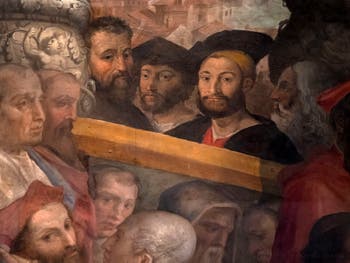
Election of college of cardinals The latter gave birth to Giulio de Medici after the death of his father.
Giulio de Medici will then be officially legitimised both by his uncle Lorenzo the Magnificent and his cousin Leo X.
Giulio de Medici himself became Pope, under the name of Clement VII, from 1523 to 1534.
Finally, in the upper left corner of the fresco, Vasari represented four great personalities of the time.
We recognise, from left to right, Michelangelo, Lorenzo II de Medici, Duke of Urbino, Giuliano de Medici, Duke of Nemours, and brother of Leo X and Leonardo da Vinci, in profile with his long white beard.
Giorgio Vasari “The Visit to Florence of Pope Leo X” Palazzo Vecchio in Florence Italy
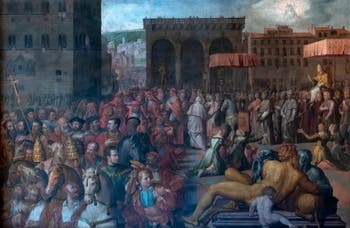
Visit Pope Leo X In 1515, during his trip from Rome to Bologna, where he was to meet the king of France, Pope Leo X made a stop in Florence where he entered through the gate of San Piero Gattolini and crossed the entire city to the church of Santa Maria Novella.
This fresco shows its solemn entrance into the city between two rows of Florentines who came to welcome it.
Leo X is represented here surrounded by the cardinals procession in Piazza della Signoria as it was still at the time.
One can see the banks of the Arno River between the Palazzo Vecchio and the Loggia since the Uffizi Gallery has not yet been built.
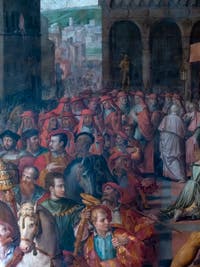
Visit Pope Leo X In front of the Palazzo Vecchio, the statue of Michelangelo's David, the Hercules of Bandinelli and the Judith and Holofernes of Donatello, half-hidden by the Pope's canopy.
Between the Palazzo Vecchio and the Loggia della Signoria, one can see the salvo of welcome and joy drawn by the guns of the gunners.
In the foreground, Vasari represented two giants.
The silver giant represents the Apennines, whose snowy mountains are still white, a giant who is also the father of the Tiber River.
The giant of the Apennines holds in his arms his son, the Arno River, represented by a golden giant leaning on a lion.
This lion of Mars symbolises the soldiers of Silla and Caesar who built the city of Florence.
In the heavens, above the palace to the right of the Loggia della Signoria, Vasari represented Saint Andrew made happy by this visit of the Pope to his hometown.
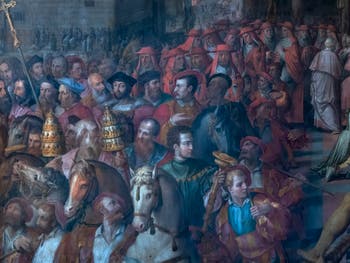
Visit Pope Leo X Under the golden cross, Vasari depicted the poet Pietro Aretino, recognisable by his long beard to the far left of the fresco.
Lorenzo II de Medici, Duke of Urbino and father of Catherine de Medici, Queen consort of France, is represented at the same height as the Aretino.
He is recognised by his triangular black hat and his burgundy coat with a fur collar.
The condottiere John de Medici, known as Giovanni delle Bande Nere is the character located two heads to the right of the Duke of Urbino.
He is on a grey horse and wears a red beret.
Giovanni delle Bande Nere was the father of the Grand Duke of Tuscany, Cosimo I de Medici.
Giorgio Vasari “Taking of the Fortress of San Leo by the Papal Troops” Palazzo Vecchio in Florence Italy
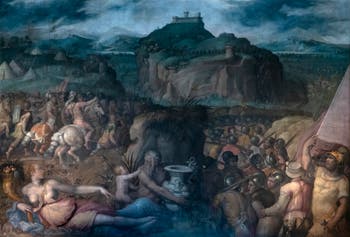
Taking of San Leo The capture of the fortress of San Leo is the highlight of the campaign of the papal troops commanded by Lorenzo II de Medici, Duke of Urbino and father of Catherine de Medici.
The Stronghold of San Leo was indeed one of the most fortified places in the Duchy of Urbino.
The fresco depicts the final attack of the rock of San Leo on September 17, 1517.
In the foreground is on the left, the allegorical figure of the young woman holding a horn of abundance is that of Romagna.
The other allegorical figure to the right of Romagna is that of the Apennines with a putto and a large vase symbolising the river Tiber which originates in the Apennines and crosses Rome.
Vasari Halls Cosimo Elder | The Magnificent | Penelope Esther Sabines | Pope Leo X
Art Story Five-Hundred | Tower | Vasari Halls | Dante Mask | Ghirlandaio | Bronzino Sarto Daddi | Salviati | Cortile
Palazzo Vecchio Art Story | Location | Opening Hours Tickets | Authorizations
Back to Top of Page


